| ←(Use Google Translate to see an approximate translation into another relevant language) |
[General index] [Index to chapters] [Index to galleries] [Full family history]
From age 2 to 11 I lived with my family in a then-rural part of northern Virginia called Chesterbrook in Fairfax County. Hardly any trace of this area remains today. Thanks to George Gilmer, Jimmie Walker, and Russell Hill for help with this chapter. It's just one part of a family history I have been writing for my children; the whole thing is here (warning: it's huge). There's an overview of it here, with links to some of the other chapters that have been extracted.
In this chapter:
You, you guys = My children Peter and Amy da CruzMom, Dad, and Pete were all WWII veterans; Mom and Dad were in the Navy and Pete the Marines. Gus was a Red Cross nurse in both WWI and WWII. A few years after moving away from Chesterbrook, I was in the Army.
Gus = My grandmother, Lenore da Cruz (née Rager, 1896-1955)
Mom = My mother, Vivian da Cruz (née Lund, 1922-2002)
Dad = My father, Frank da Cruz (Sr.) (1918-1990)
Pete = My uncle, Daniel da Cruz (Dad's brother, Gus's son, 1921-1991)
Dennis = My little brother (1949-1978)
Howard and Lita = Our friends in NYC 1970s-80s
Sarabecca = What you guys called Howard and Lita's children, Sara and Rebecca
—Frank da Cruz <fdc@columbia.edu>
Most recent update: 12 February 2025 12:03:33
Chesterbrook VA 1947-56
- Chesterbrook, Virginia, 1947-56 gallery (black and white snapshots)
- Chesterbrook, Virginia, 1947-56 gallery (color slides)
- Chesterbrook School 1954-56 gallery
- Chesterbrook Little League 1956 gallery
- Chesterbrook aerial views 1953 and 1960
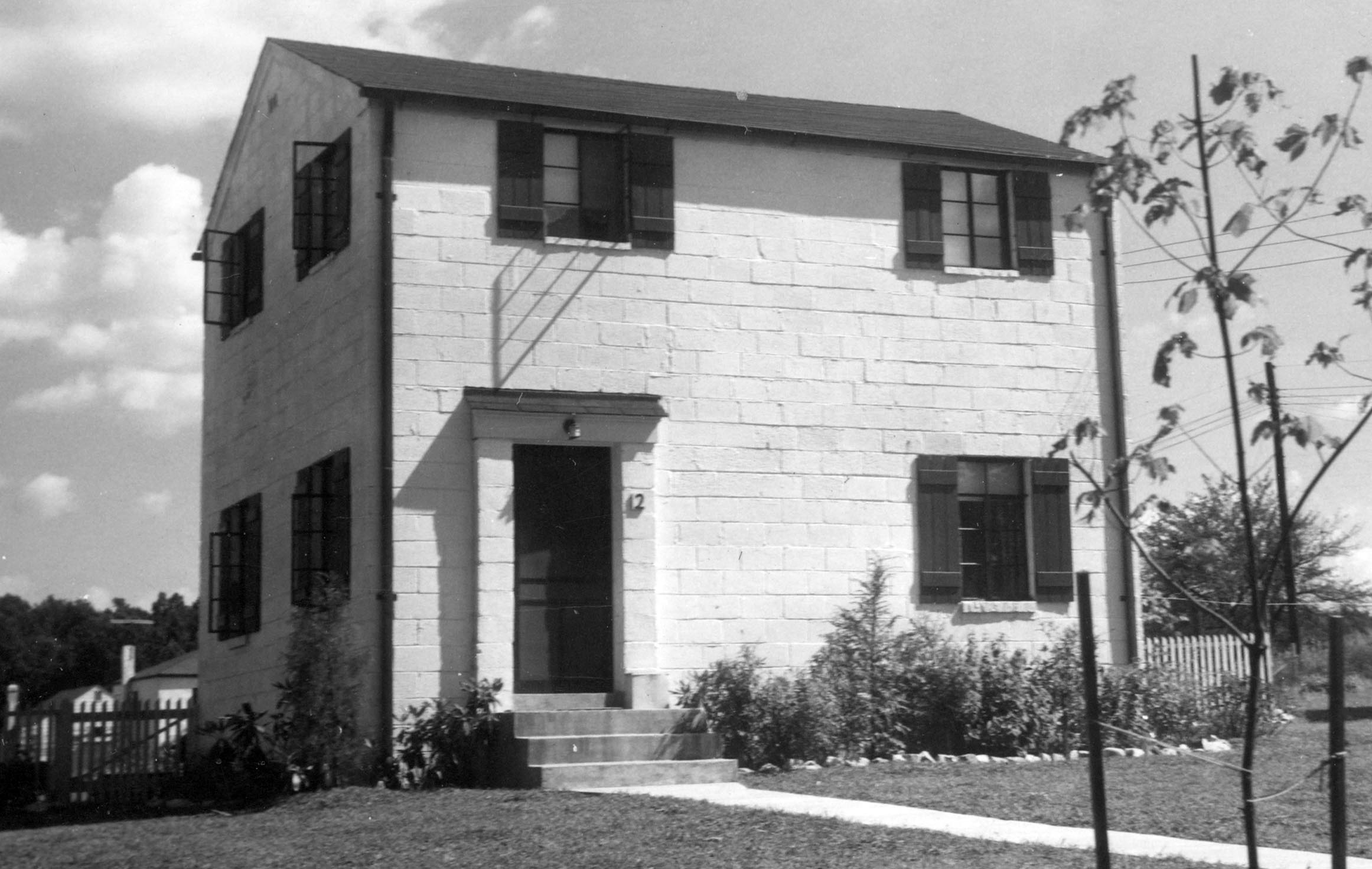
|
| House on Kirby Road 1947 |

|
| Map of the area |
New (July 2024): CLICK HERE for aerial views from 1953 and 1960.

|
| View down the hill - GI-bill cinderblock cubes, late 1940s |

|
| Tyson's Corner 1950s |

|
| Bond Bread door |

|
| Our back yard (and the Walkers') |
The road our house was on was a dirt road until about 1955. When the road needed work and when it was finally paved, the work was done by chain gangs of Black prisoners.

|
| Manassas battlefield - Click to enlarge |

|
| Harry and Avis 1960s |

|
| Harry Hill mid-1950s |

|
| The Hill farm 1950s, barn at right |
The Hill Farm
Just up the road a couple hundred feet was the Hill farm: Russell and Avis Hill and their son Harry, who was one my major childhood friends, and Avis's mother Helen Walker; Avis grew up on this farm, Russel grew up on another farm down the road. Harry was like Huck Finn, always getting into trouble. The farm was 40 acres, usually fallow but sometimes Russell would plant a crop of tobacco or rye on the least-recently-used quarter of land. I remember tobacco drying in the barn, of which you can see a piece in the photo; it was bigger than it looks. There were other outbuildings too, and all kinds of rusty old plows and harrows and rakes and rusted hulks of 1920s pickup trucks and old school buses scattered over the land. But he did have a working tractor; I used to ride on it with him. I spent a lot of my time there. Avis would often give me lunch (invariably Campbell's tomato soup and piece of toast). One day when we were sitting around the kitchen table at lunch, Russel sees something in a tree out the window, grabs his shotgun (which is leaning up in the corner right next to him) and shoots it...BOOM!!! "Goddamn crows!" It happened in a second and I could hardly hear anything for the rest of the day. He was always playing tricks on me, like getting me shocked on electric fences, giving me whisky to drink, etc. But on the positive side he showed me how to make apple cider, how to get walnuts out of their husks, how to use a plow, how to play Edison cylinders, how to castrate a horse (he had a special tool for that), how to painlessly kill a litter of unwanted kittens... (Not that I ever did the last two!)The Hill farm by our house belonged to Avis's family, it's where she grew up; her mother (Harry's grandmother) Helen Walker still lived there. Russel grew up on a much larger Hill farm down the road. After we moved away he and Avis sold the farm to real estate developers for a lot of money, enough replace the farmhouse (on the corner he kept) with a much larger new house, and also to buy a much larger farm in Warren County VA. Russell died in a car accident 1966 and Avis died in 1995.
The Walkers

|
| Nolan Walker |

|
| Mary Walker, Mom |

|
| Jimmie Walker 1956 |
- 1950 census p.1 (Adams, Walker, da Cruz, Cason, Hill)
- 1950 census p.2 (Hill, cont'd)

|
| Farms in the area about 1890 (Salona Farm) |
Farm animals roamed free (no confining them into tiny boxes for their whole life, as is done now) — cows went out to pasture in the morning and "came home" to the barn at night, where they were milked the next morning, usually by the children. The farm ladies used the expression, "til the cows come home". They didn't actually come home by themselves; the kids would go out bring them in, so the expression actually meant either "never" or "forever", depending on context. There was always a big shade tree where the cows could lay around in the shade on hot summer days, when the temperature could go to 105, and there were electric fences to keep the cows in the pasture, and within it big well-worn salt licks for their enjoyment. For us kids, the cows were fun to play wish but also a little scary when they chased us.
Chickens lived in a big airy coop where they could run around and it didn't get all stinky. Rabbits lived in hutches that they chewed their way out of. Pigs had their own big area for wallowing. Geese, ducks, dogs, and cats ran free and the roosters crowed at sunup (and a course of dogs chimed in). The main meal was served at noon, all the family and the hands around a long table heaped with fried chicken, mashed potatoes, greens cooked in hamhocks, and home-baked biscuits, with fresh-made lemonade to drink. The farmers — Black and White alike — helped each other out, shared equipment, and socialized.
When I was about ten I bought a bicycle for $40 that I had saved up from my 25¢/week allowance and 75¢/hour wages digging postholes and I went all over the place on it by myself, on the country roads, past farms and fields, along forest paths, to distant towns just to get some little treat. When Little League started in 1956, sometimes the practices or games were miles and miles away and I'd bike there. It was a good bike, it was like an "English racer" (i.e. thin tires and frame) but instead of handbrakes, which I thought were stupid, it had pedal brakes. There were big hills where I could go down at 40mph (I had a speedometer). I never wore a bike helmet, never even heard of such a thing. Ditto later in life when I had bicycles in NY, you guys had helmets for when Mommie and I took you on long rides sitting in baby seats on the backs of the bikes… around Central Park, over the GW Bridge to NJ, etc. Sometimes we'd go with Howard and Lita and Sarabecca.
Howard was my friend (and boss) from work, our families were very close from before you guys were born until 1984, when they moved away. Howard died in October 2022, I wrote a eulogy for him HERE.
Aside from the bike, the other thing I used money for as a kid was buying plastic models of WWII airplanes and gluing them together. No, I wasn't a glue sniffer. Later on, after we moved to Arlington, Ludwig and I blew them all up with cherry bombs.

|
| C&O Canal |

|
| Hopfenmaier Rendering Plant |

|
| Postwar margarine |
Mom always gave us a hot breakfast because it was "the most important meal of the day": eggs, bacon, toast, applesauce, and milk. She saved the bacon fat in cans and jars and used it for cooking instead of oil. Sometimes we had oatmeal, and on special occasions pancakes or waffles. One of the main compulsions I still have from those days is to never to waste food (or soap... we used to save the tiniest slivers of soap and combined them into new bars, a habit left over from wartime rationing). Sometimes they couldn't afford coffee (or it was still scarce) and drank Postum.
Mom made our clothes (and her own) herself and washed them in a tub a with a washboard and brown soap. If she needed to make a phone call she used the neighbors' phone. We didn't go anywhere. This existence made my mom pretty depressed. But at the time I didn't think any of this was unusual because it was all I knew. Little by little my dad earned more money; I remember the big milestones: a real toaster, a Maytag cast-iron washing machine (with a power ringer), in 1950 a new Ford, and finally about 1953 or -54, a TV (so I lived the first 9 or 10 years of my life without television, and then another five years while in Germany, and another 2 years after the Army, so about 17 out of my first 24 years with no TV).
For health care there was a dentist, Dr. Cooksie (I barely remember him) and a husband-and-wife medical practice, Dr. Willard and Dr. White, in Arlington close to my grandmother's house. If I got sick with measles or mumps or chicken pox (I had all those) my Mom would call from the neighbor's house and Dr. Willard would come in his car. For measles they had to make the house dark inside for a week. When I was five, evidently Dr. Willard told my parents that I needed to have my tonsils and adenoids out, and to be circumcised. Standard practice in those days except circumcision was normally done a birth, not at age 5... Ouch! (in a 1949 letter from Dad to Pete announcing the birth of Dennis, he says "We had this boy circumsized, and I curse the Navy doctor who was too bored to perform the same assistance to Bubba" [me]). A visit to or from Drs. Willard and White was $5.00. I had to go every six months to have the wax removed from my ears... it built up until I was just about deaf. But after I was 10 or so it didn't happen any more.
Mom used Norwegian words in everyday speech but I didn't know they weren't English. The main ones I remember are "takk skal du ha" (pronounced tuks-guh-duh-HA) meaning thanks very much, "skærk" (not sure of the spelling), meaning crust of bread (as in "eat your skærks!"), "hutfeduma!" meaning "Damn it!". She also called a head scarf a "babushka", I don't know where she got that! My dad, on the other hand, never showed any sign that his father was Portuguese.

|
| Radio/phonograph console 1946 |
Movies in those days were creative, made with live actors, original scripts, original ideas, usually based on real life, not comic books. There were hardly ever sequels (with exceptions like the Thin Man and Tarzan). Going to movies was fun, not painful. Admission was a dollar or less, there were no ads, theaters were lushly decorated, clean, and comfortable, there were ushers, and there was a huge velvet curtain that opened when the show was about to start. The show consisted of a newsreel, previews, sometimes a travelogue, on Saturday afternoons a serial ending with a cliffhanger, a Disney or Warner Brothers cartoon, and then the feature. After we moved to Arlington when I was 11, the Glebe theater was just a couple blocks away and kids got in for a quarter. I saw all the famous monster and science fiction movies there: Creature from the Black Lagoon, This Island Earth, Forbidden Planet, Invasion of the Body Snatchers, The Incredible Shrinking Man, Godzilla, some of them about space, others about about monsters created or awakened by atomic testing.

|
| Reading the Sunday Comics 1952 |
Our TV arrived about 1954. Early TV included (evening) the variety shows of Sid Caesar, Ernie Kovacs, Milton Berle, Martha Raye, Ed Sullivan… Late at night were old movies and also the Tonight Show with Steve Allen, which was a tremendous improvement over its successors. Kid shows on Saturday morning were Froggy the Gremlin (Andy's Gang), Sky King, Cisco Kid, Watch Mr. Wizard… And of course cartoons, mostly from the 1930s. We also had some Confederate-themed TV shows in Virginia like The Gray Ghost and Mosby's Raiders. There were a few kid shows in the evening too, just before dinnertime: the Lone Ranger, Zorro, Robin Hood, and Superman. And later, the Wonderful World of Disney, which almost caused the extinction of the racoon when they showed Davy Crockett in four episodes in 1955 ("Born on a mountaintop in Tennessee, kilt him a bar when he was only three...")

|
| Maytag washer |

|
| Pressure cooker |
There was no kindergarten, let alone pre-K, where we lived. But my Mom wanted me to learn to read and write and do arithmetic starting when I was 4 or 5, so while Dad was at work she'd spend a few hours with me each day reading from books. For arithmetic she made flashcards, and for handwriting… When she was a girl penmanship was very important, and she did have beautiful handwriting. As a child she had to spend hours every day practicing overlapping curliques on lined paper, so I did some of that. Thanks to all these lessons, I was pretty advanced when I started school and usually did well. (My Mom was so quiet and self-effacing that as a child I never appreciated how many technical skills she had; I knew her as "just a Mom".)
Chesterbrook Elementary School and the churches

|
| The Methodist church early 1950s |

|
| Chesterbrook School with Quonset hut (demolished in 1978) |
Mostly farm kids went to Chesterbook school then; probably half the kids were in the 4-H Club, which in those days was mainly about raising farm animals, growing vegetables, canning and preserving, etc. Once a year there would be a fair at the school where the 4-H kids would bring the calfs or pumpkins or jam in hopes of a blue ribbon. The photo on the right, taken on the bridge over Old Dominion Drive, shows the Methodist church (1920) and to its left, the house of county Sheriff Carl McIntosh, who was married to Russell Hill's sister Jesse. Harry and Jimmie and I used to hang out there sometimes and Jesse would put us to work shucking corn or shelling peas on the back porch while Carl entertained us setting off firecrackers he'd confiscated from juvenile delinquents.

|
| View from Chesterbrook School in 1952 |
The First Baptist Church was founded in 1866 by Reverend Cyrus F. Carter to serve newly freed African slaves in the area. Reverend Carter was born a slave in Port au Prince, Haiti, in 1815 and he had been enslaved for some time in Lancaster County, Virginia. He was emancipated before the end of the war and served as an ambulance corpsman for the Union Army [Source: African American Historic Resources in Fairfax County, Mary Ruffin Hanbury and David W. Lewes, 16 December 2022].
Both churches are still there but the simple frame houses beyond the Methodist church have been replaced by mansions and condo complexes — the same that happened to Hall's Hill, the Black community in nearby Arlington — as have the houses down the hill and, for that matter, along the entire length of Kirby Road. Chesterbook is no longer a modest community of slave descendents and returning veterans.
Left of First Church (not visible in the photo), the house of an old guy who kept a cow tethered by the front porch (but apparently not when this photo was taken). The cow was a source of fascination to all the schoolkids because its horns were growing downwards, curving around towards its big eyeballs, closer every year. When I moved away in 1956, the points of the horns were a quarter inch from the eyeballs. This still worries me.

|
| 4th grade at Chesterbrook School 1954 |

|
| Virginia witch face |

|
| Chesterbrook School 1953 annex, Quonset huts, incinerator |
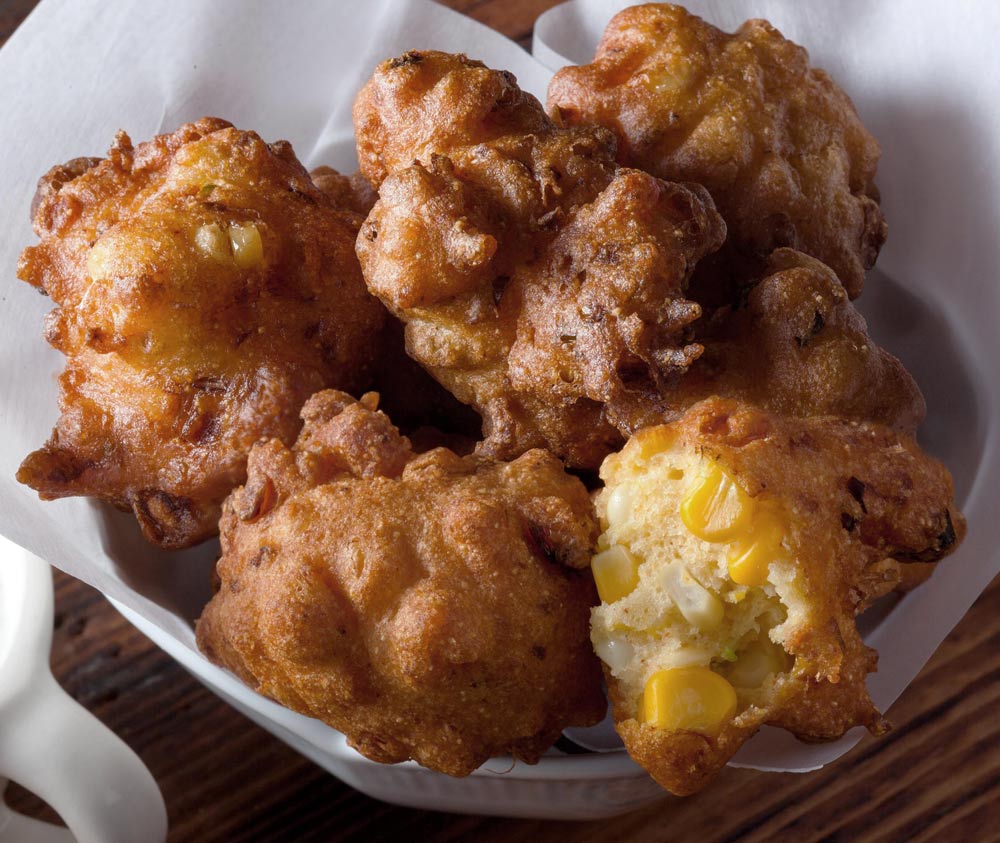
|
| Corn fritters |

|
| Smithfield hams |
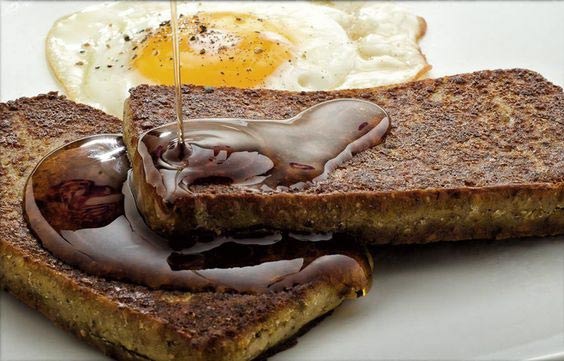
|
| Scrapple, eggs, and syrup |

|
| A 17-year locust |

|
| A pile of dead locusts |
I used to get horrible cases of poison ivy, I can't even describe how bad. For example my fingers would fuse together, my eyelids would swell shut, it would be all over my body… Anyway, once I had a case so bad in second grade I was out of school for two weeks, and when I came back I was so far behind that they just put me in 3rd grade and that's how I skipped a grade.
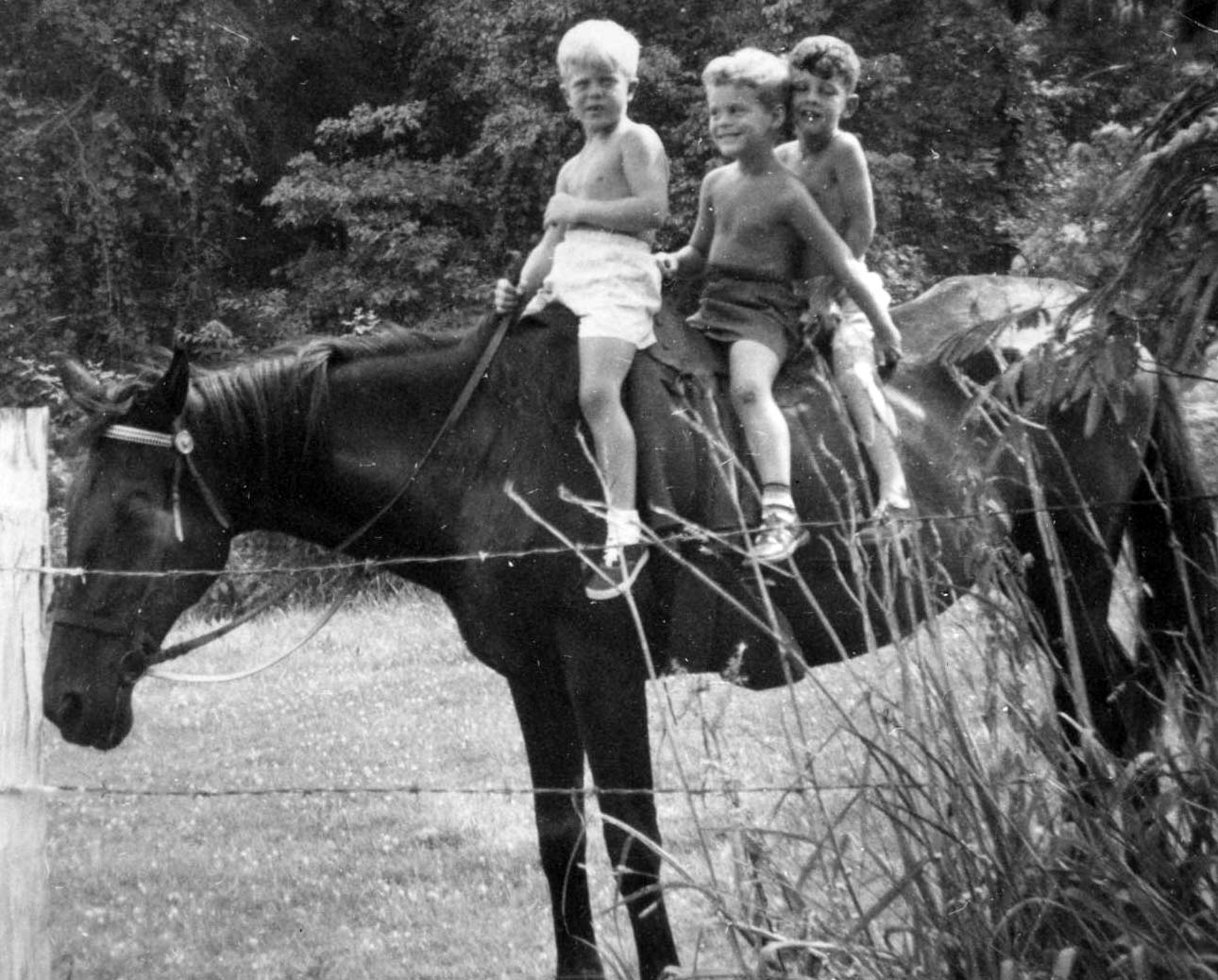
|
| Me, Jimmie, Harry at a nearby farm |

|
| Back of Hill farm |

|
| Sámi marking knife |
In early years my mom shopped by calling up the market from the neighbor's phone and reading her shopping list; later a guy named Frank, who had several fingers missing, would drive up in an old rusty pickup truck with the order. After we had a car, we drove to McLean to shop at the Safeway supermarket (not very super), where a week's groceries for four cost $25.
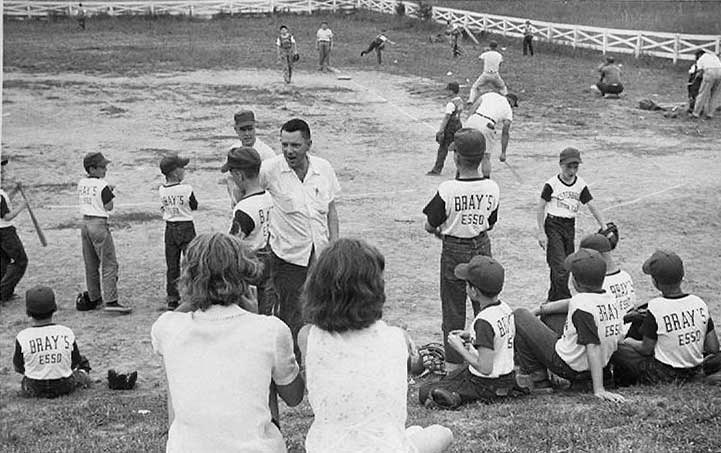
|
| Little League game 1956 |

|
| Bray's Esso Little League team 1956 |
Segregation
It was the segregated South, but the lines were not super-firm. For example, in the house behind ours was where my friend Ricky James lived. His dad was white but his mom was Jamaican and Ricky (second from left, back row) was somewhat brownish but went to the white school, as did a number of other kids (e.g. two rightmost kids in back row) who were not exactly white but were not black either. Also for part of one year I had a Black teacher in our segregated white school. Go figure. Also the stores weren't segregated; I never saw Colored and White signs on anything except when I went further south, like to Charlottesville.While the school and churches were segregated, the farms were not. A prominent farmer, Lewis Hall, was black and his family and Hill family were good friends and frequent visitors. I went with Harry's family sometimes to the Hall farm on Cottonwood street about a mile and half northeast of us along Kirby Road, when they visited and Harry and I played with their children, who were a bit younger. It's solid suburbs now of course.
The Gilmer family

|
| George Gilmer 1954 |

|
| George Gilmer 1958 |
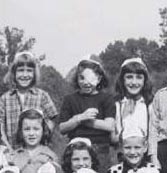
|
| Beedee (center) 1952 |

|
| John Gilmer 1945 |

|
| Cinderblock cubes a few months later |

|
| Gilmer house and car January 1947 |

|
| Gilmers' house, top center, 1955. |

|
| Virginia, Beedee, George 1950 |

|
| Gilmers 2017 |
Link: George Gilmer Obituary, Kyger Funeral Home, Harrisonburg VA.
Other families in the neighborhood
A lot of other families beside the Jameses lived in the house behind ours. Once there was a family of (what everybody called) hillbillies: man and wife with 10 ragged dirty snotnosed kids ranging in age from infancy to about 10. Every night in the summer the whole family would sit in a circle in the back yard, all of them smoking cigarettes except maybe the babies, while the dad sang and played guitar. That was the first time I ever saw a guitar. I'd go there sometimes and he'd show it to me. In retrospect, he reminds me of Hank Williams or Woody Guthrie.

|
| Mona Joseph 1955 |

|
| Mona and son Philip |
Mona was one of those people who knew how to do everything, you had to admire her. She spoke French, English, and Arabic and/or Berber. She showed my Mom how to make her Algerian dishes, so without knowing it I grew up eating Algerian food (when we could afford the ingredients): lamb cooked with "french style" string beans and tomatoes in sauces like the Lubee in Samad's with Magreb spices like cinnamon, cumin, coriander, and nutmeg. I always remember Mona in the backyard swinging wet lettuce around in a wire basket to dry it for salad, the droplets shooting out in great arcs and catching the setting sun.
Country life
Chesterbrook being rural, kids' lives were pretty rough compared to most kids today. I got in fights with other kids all the time. Bullies always picked on smaller kids, they'd take my hat or my lunchbox and I'd have to fight them to get it back. Once in a fight at school, I knocked a kid down and his head hit a rock; he got a concussion and had to go to the hospital. I was in big trouble for a long time.I was stung by bees and wasps almost daily, bitten by dogs, shot with BBs and once by an exploding shotgun shell. One time some older kids jumped me when I was taking a shortcut through the woods and tried to rob me at knifepoint but somehow I fought them off without getting cut. They wanted the $10 Timex watch my grandmother Gus had given me (they didn't get it). Anyway it was such a common occurrence that I came home bruised and bloody, my parents barely even remarked on it. I broke my nose lots of times, which is why it is so lumpy and misshapen now; fights, football… And once at Fort Knox I dived off a high board and smashed my face onto the pool bottom; I was unconscious underwater for some unknown number of seconds, I woke up and everything was red, swam to the surface.
Speaking of insects, we used sit out in the back yard at night and the most amazing kinds of bugs would swarm around the single yellow lightbulb over the back door: gigantic moths, creepy monster mosquitos, ... and in the grass, big fat black beetles the size of a golf ball with pincers and lobster claws… Across the road, the woods was full of box turtles and snakes, stickbugs and praying mantises. And hummingbird moths... a moth that looks like and mimics a hummingbird. The creek in the woods had crawfish. The ditch in front of our house was full of frogs and tadpoles (and mosquito larvae of course).
Other common injuries in the country involved the shins. Geese on the farms always went for kids' shins, chomping down with their tiny sharp teeth. But even more annoying were the old rusty barrel hoops lying hidden in the grass… when you step on one, it flips up and whacks you with its sharp edge right in the shin. This was similar to stepping on a rusty nail, another common occurrence. You were supposed to get a tetanus shot when this happened so I didn't say anything about it.
And playing, we did things so dangerous I can't believe I didn't get killed. We totally ran wild, no such thing as adult supervision. One thing I remember was, when they started to clear the forest to build the new suburbs, they put all the trees in a huge pile, 30-40 feet high. On a day when nobody was working we went there, climbed up on it, and discovered we could slide down through the interior, zooming down through dark twisty passages. It's only blind luck that I didn't impale myself on some broken branch that was pointing in the wrong direction.
Sledding on the farms in the winter could be tricky too. Once there was a deep snow that buried the barbed wire fences and I crashed into one at full speed with my face; I could easily have lost an eye or two.
Another time, I climbed on a bulldozer that was left in place overnight in front of the house when they were paving Kirby road and fiddled with the buttons and levers until it started and I was heading down the road but my dad noticed and caught up with me and turned the thing off. Good thing too, I had no idea how to steer it or to stop it.
Another time I fell out of a tree from about 30 feet up, but wasn't hurt too bad. But then another time I was swinging at the Hill farm on an ancient tire swing that hung from a big tree branch that was 30-40 feet up and the branch broke off and landed on my head. I was unconscious for a while and when I woke up I had lost all memory of recent times, I could only remember things from years before (this was after I had moved to Arlington, but I didn't remember that I had moved). Harry's Mom Avis very gently and patiently helped me recall everything.

|
| Hill farm in 1900 |
The first movie I saw was Song of the South in 1946, with Uncle Remus, Brer Rabbit, and Zip-a-Dee-Doo-Dah. This must have been at the Glebe theater in Arlington when we were living with my grandmother Gus, it was just a couple blocks away. It's never been released since then because it's full of stereotypes, but it's kind of sweet, not vicious. A lot of people thought it sugar-coated plantation life during slavery, but actually it's set during Reconstruction.
I remember going to another movie in 1949, after we had moved to Chesterbrook: an Esther Williams extravaganza in color. The whole family went in our brand-new 1950 Ford, purchased probably around October 1949, when Dennis was about six months old. The theater had a special glassed-in balcony for families with new babies (crying, breast-feeding, changing diapers...) — this was, after all, the post-war baby boom. It was the State Theater in Arlington; I read somewhere it was the first movie theater to have air conditioning. After the movie we went to the drug store next door and sat at the black marble soda-fountain counter on red leather revolving stools and had ice cream treats. It must have been a birthday.
Aside from that I remember seeing other movies with my parents and Dennis in the baby balcony at the State, mostly black and white — first-run movies with stars like Humphrey Bogart, Ida Lupino, Johnny Weissmuller (Tarzan), Marilyn Monroe in her early noir roles…
The Chesterbrook community swimming pool

|
| Chesterbrook pool site about 1953 |

|
| Opening ceremony 1954 |

|
| Chesterbrook pool 1955 |

|
| Chesterbrook pump house 1953 |
Photos by my father. In the 1954 photo (infrared) you can see a band at the far end, with a big string bass. In the 1955 photo you can see the new wing of the school peeking through the trees at far right, above the car. It was a "swimming club", members-only, with a moderate annual membership fee. At some point after we moved away in 1956 it opened its membership to Black people. Click each photo to read more.
My mom and dad liked the pool too, but they weren't good swimmers. Mom swam with her face in the water, so could go only as far as she could hold her breath. My dad could do the crawl properly, and he'd do a lap or two but with no joy, as if only to show everyone how it was done. Whereas I did every kind of stroke including invented ones, swam on the surface and underwater, splashed, played, dived off the low and high boards, and always had great fun.